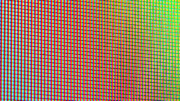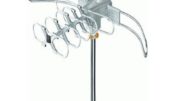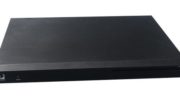Disclaimer: Look, there are going to be some really smart enthusiasts who will want to nitpick this article. I’m not trying to go super-technical here. I’m trying to explain a complex subject in a way that makes sense.
As you continue to learn about the world of antennas, there is no question in my mind that you will hear the term “quarter-wave dipole.” It sounds like a kind of inaccessible, techie term. But there’s nothing to be scared of here. But, in order to understand this term, you have to understand something about radio and television electricity.
Broadcasting is really wireless electricity.
The history of broadcasting is the history of very small steps. So, it’s not fair to say that one person or another really “invented” it. One of the bigger steps, though, was made by Heinrich Hertz. Electricity was a novelty for most of the 18th and 19th centuries. It wasn’t thought to have real-world applications. Based on prior theories, Herr Hertz discovered that you could send electricity through the air in a predictable way. The electricity that was received had the same characteristics as the electricity that was sent, except for being weaker.
This may seem like a really small thing but it’s the basis of all broadcasting. It’s also the basis of wireless charging, Bluetooth, Wi-Fi, and more or less every other thing that makes our modern world possible.
The wave theory of electricity
A physicist named James Clerk Maxwell theorized that all electromagnetic radiation traveled in waves. This was pretty serious fantasy in 1864, and it turns out he was right. What differentiates all colors of light, as well as all the other kinds of transmissions like X-rays, cellular, infrared, and others, is the size of its wave. Not only that, but it’s since been established that you can broadcast on one wavelength and for the most part that doesn’t interfere with broadcasts on other wavelengths.
That las bit is really important too because otherwise there would only be one broadcast station and that’s it.
How broadcasting and reception works
This is probably the part where the purists will want to rip me apart.
To put it simply, if you broadcast an electrical signal from one place, the same signal will be received at another place. So you can put all sorts of spikes or irregularities into that signal and they show up at the point of reception. You can take those spikes and irregularities and form them around a wave of a single size and they’ll be received by an antenna that’s designed to receive that wave. We call this modulation and it’s another key part of broadcasting.
How do you know what antenna will pick up one wave?
First you need a material that is a good conductor. In other words, electricity has to flow through it easily. A material like glass is not a good conductor and the waves will bounce off. Their special characteristics will be lost. A material like aluminum is a very good conductor. Most metals are.
The other thing you need is an antenna that’s the right length. The best antenna for a particular size wave is one that’s exactly the same size as that wave. If your wave is about 6 feet long (TV channel is about this length) then your best bet is an antenna that’s about 6 feet long.
You also need the right shape. The most efficient antenna design is called a dipole. It’s a pair of metal rods that sit opposite to each other, angled in such a way that they face the source of the wave lengthwise. That’s some technical terminology there, and it just boils down to two pieces of metal.
Tying it all together
Getting back to the term “quarter-wave dipole,” we now have all the information we need to explain that funny-sounding term.
“Quarter-wave” means that the antenna is one-fourth the size of the wave. Antennas that are even fractions of the size of the wave — like half, one-fourth, one-eighth, etc — aren’t as effective as ones that are the exact right size but they’re still effective.
In the case of TV broadcasting it just doesn’t make sense to have antennas that are the full wavelength. A full-length antenna for channel 2 would be about 20 feet wide. Generally an antenna one-fourth the size of the wave is about right.
Since you also know that “dipole” is a kind of antenna, then a “quarter-wave dipole” is an antenna that’s about 1/4 the width of the wave it’s trying to receive.
Now isn’t that simple?
Shop for antennas and accessories at Solid Signal
You’ll get the best quarter-wave dipoles, plus everything you need for any antenna project, when you shop the great selection at Solid Signal!





